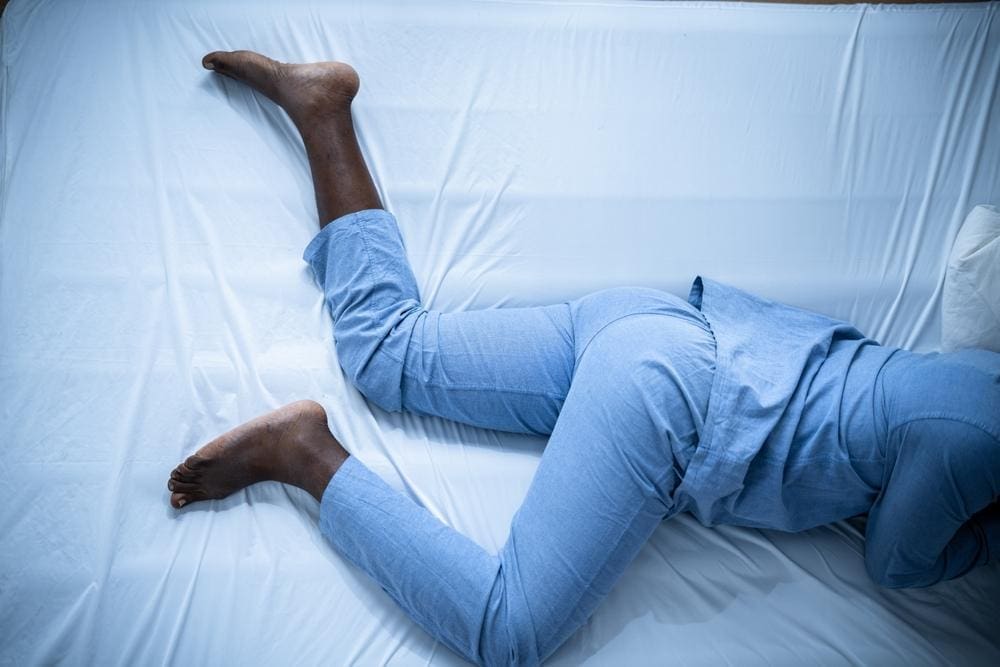
Restless leg syndrome is a common condition causing uncomfortable sensations in the legs, often making sleep difficult. Find out how chiropractors can help.
At night, you may experience an irresistible urge to move your legs, and gnawing, itching, or crawling sensations on your leg even when nothing is there. Restless leg syndrome (RLS) is a condition that seems to flow with the circadian rhythm and affects the quality of your sleep. Thankfully, chiropractic care can help treat restless leg syndrome and restore quality sleep in your life.
Restless leg syndrome or Willis-Ekbom disease is the irresistible urge to move your legs because of uncomfortable sensations. The feeling is not necessarily leg pain. The sensations may be crawling, itching, tugging, throbbing, or burning. RLS wakes you up and prevents you from falling asleep once you’re awake.
The uncomfortable feeling gets worse in the evening when sleeping or resting. Jiggling your foot or moving around provides short-term comfort, hence the term “restless leg syndrome.”
RLS is a movement disorder since it interferes with your movement; it is a sleep disorder because it interferes with your circadian rhythm. However, it is best to categorize RLS as a neurological disorder since most sensations come from the brain.
RLS occurs at any age. It affects about 10 percent of the American population. However, RLS is more common in women than men, especially in pregnant women.

RLS symptoms vary from person to person and in severity and frequency. The hallmark symptom is the irresistible urge to move. It is important to note that the symptoms usually flare up in the evening, and you experience a distinct symptom-free period in the morning. Common symptoms include:
The crawling and itching sensations in your legs when you rest or sit may be initial signs of RLS. The sensations disturb your sleep, and you also have trouble falling asleep or staying asleep for long periods. A long flight or sitting at the office desk for many hours usually aggravates the symptoms.
A slight tap on your leg, shuffling your feet, or taking walks minimizes the uncomfortable feeling. Constantly keeping your legs in motion helps to ease the sensations. The restlessness affects your work behavior and is a nuisance to people around you.
RLS seems to follow the circadian rhythm. The symptoms worsen in the evening when lying down or sitting. The symptoms advance into the night, detracting from the quality of your sleep.
RLS affects periodic limb movement, increasing twitching in the legs, especially at night. Jiggling your foot usually provides short-term relief.
The symptoms usually occur once or twice a week in moderate cases. You may experience remissions in the initial stages; however, the intensity of the symptoms increases over time. RLS that accompanies a disorder usually causes the symptoms to worsen more rapidly than in patients with non-disorder-induced RLS.
The pathophysiology of RLS is unclear. However, many scientists purport there is a genetic link. Research shows that up to 92 percent of people with RLS have first-degree relatives with the same syndrome. Hereditary RLS usually starts before the age of 40.
Also, neurologists suggest the disorder is a central nervous system problem since it affects the nerves, basal ganglia, and dopamine pathways. Other causes besides the genetic link are:
Iron deficiency anemia causes your muscles to tire since they don’t receive enough oxygen. Iron deficiency anemia may cause RLS since it affects nerve relays and causes weakness in the leg muscles.
Uremia is a condition associated with worsening kidney function. Uremic RLS affects your sleep the most. The decreased renal function leads to the accumulation of substances that imbalance the CNS, causing RLS.
Hypothyroidism affects the balance in the endocrine system and subsequently the dopaminergic system, inducing RLS.
Depression lowers the dopamine levels just like hypothyroidism does. Clinical samples of RLS patients show they are also likely to have depression.
Fibromyalgia is a sleep disorder that affects the nervous system. Since it is a central sensitivity syndrome, it may induce RLS.
Dopaminergic medications for Parkinson’s disease also treat RLS. Scientists link the two conditions since they are both neurological disorders that affect the nigrostriatal system. In essence, the two conditions are dopamine-related, and one may cause the other.
Kidney diseases such as kidney stones decrease renal function and filtration, which leads to a buildup of toxic substances that affects nerve functions and dopamine pathways.
Diabetes, kidney failure, and RLS have negative interdependencies. In particular, diabetes mellitus increases your chances of having RLS. Damage to the nerves caused by diabetes induce irritable feelings in your leg.

Chiropractic care for RLS is a non-pharmacological treatment that has proven efficacy. A case study of a 42-year-old male showed he had a 65% reduction of RLS symptoms within a month of chiropractic care.
Chiropractic treatments combine multiple modalities such as spinal manipulation, electro-micro current therapy, cryotherapy, stretches, and instrument-assisted manipulation.
The chiropractor performs motion and imaging examinations to assess the spinal structure. Spinal adjustments realign the spine, relieving nerve pressure and improving nerve flow to treat RLS sensations. Easing pressure on the joints and the spine also reduces stress on the brain stem, hence improving the CNS function.
The adjustments also improve the joints’ range of motion since they improve overall joint function. Chiropractic care for restless leg syndrome primarily leverages high-velocity, low amplitude adjustments that work for sections of the lower spine.
Chiropractic treatment essentially arms your body with the tools to promote self-healing. The holistic approach is one of the reasons it confers many benefits. You receive inflammation-reducing and pain-easing treatment in one non-invasive method.
RLS affects your sleep quality and ability to hold down a job. You do not have to keep moving to stop the uncomfortable sensations of RLS. Instead, book yourself in a chiropractic center to receive personalized care that improves your symptoms.

© Accident Care Chiropractic | Hablamos Español
Located in: North Portland, NE Portland, SE Portland, Gresham, Clackamas, Oregon City, Hillsboro, Bethany, Beaverton, Tigard, Forest Grove, Woodburn,
McMinnville, Keizer, Salem, South Salem, Bend, Springfield, Vancouver, Hazel Dell, East Vancouver, Pasco, Kennewick, Lakewood.
We Specialize in Car Accident Treatment & Recovery
Home | About Us | Testimonials | Blog | Sitemap | Privacy Policy | Services | Locations | Contact Us